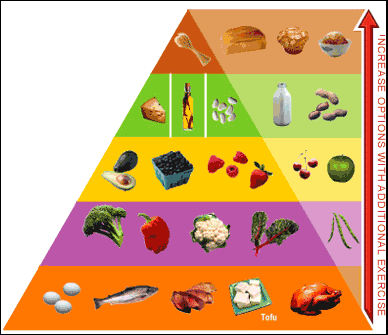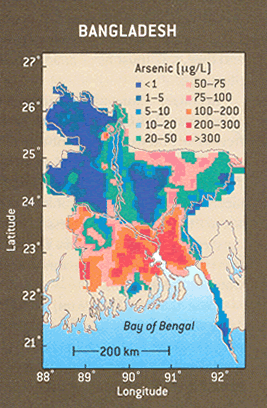The basic food pyramid is developed by the U.S. Department of Agriculture and supported by the Department of Health and Human Services. It is used as dietary guides for Americans. The Atkins's food pyramid (Figure 1) modifies the basic pyramid and is developed by Dr. Robert C. Atkins and his associates (http://atkins.com).
Why is it good?
Figure 1 conveys a number of important information using a simple, easy-to-understand
diagram. The relative sizes of the area occupied by the five food groups
indicate the relative recommended daily intake of those foods. Commonly
encountered foods are used both as examples, and examplars of the food
groups. Note that this is achieved without the need to name the groups,
and thus remove the visual complexity of hierarchical grouping.
The relative recommended intake is reinforced by the pyramid metaphor,
where the "base" of the pyramid also implies "foundation".
Applying this metaphor to food intake, the bottom food group is therefore
the "foundation" or basis of the recommended diet. The
pyramid metaphor is visually displayed as a triangle. In addition
to being visually consistent with the pyramid metaphor, the triangular
shape creates an perceptual illusion of increasing row height going from
top to the bottom of the pyramid despite the equivalent row heights. This
visually reinforces the emphasis on the food groups at the bottom of the
pyramid..

Figure 1: Atkins Food Pyramid.
Source: Atkins Nutritionals
http://atkins.com/Archive/2004/2/10-121449.html
-
Is on the side, i.e., does not visually pollute the main basic food pyramid;
-
Extends the basic pyramid by providing further examples of the food groups, especially for the upper groups where in the basic diagram, space have been limited;
-
Is visually linked to the basic food pyramid by alignment and colour, so as to indicate the extra food group options made available with additional exercise--starting from the basic protein sources and move up the pyramid;
-
Reinforces the basic philosophy of the diet by showing the recommended daily intake of the least desirable food group will never be as much as that of the bottom groups despite exercise;
-
Builds on the pyramid metaphor where the arrow points up against gravity to indicate increasing exercise, which implying physical exertion, and perhaps progressively more so when at higher "altitudes".
